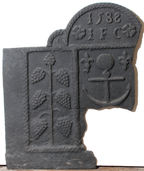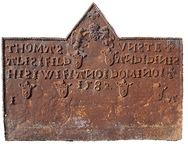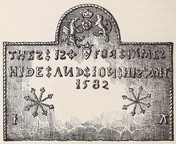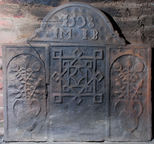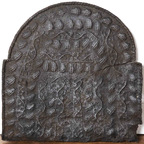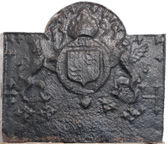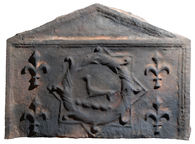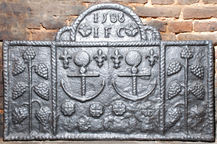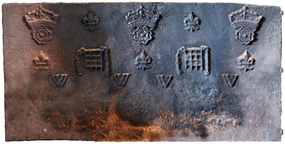-
439
Description: Fragment; left part only; this fireback comprises at least four separate elements: the rectangular central panel has an anchor with coiled rope between two fleurs de lys, below which are two roses; the rectangular side panels each comprise a vertical stem with six ‘grape bunches’ surmounted by a circular grape cluster; above, a semicircular arch contains the initials between two roses as in the central panel, with the date above; where the arch meets the central panel there is an arc across each corner. The side and top panels are edged with simulated twisted rope; to the left and botoom, a plain extension has been added before casting.
Notes: One of an unusual series formed from separate panels. The left panel is likely to have been repeated in the missing section. The extensions to the side and bottom will be unique to this casting which, because of the sharpness of the relief detail, is probably an early example. Because of its date and the use of the anchor motif, this much-copied plate is often referred to as the Armada fireback. No other connection with the sea battle is known. Other firebacks have been cast using some of the separate elements described.
Inscription: 1588 / IFC
- Decoration tags:
- rectangular with round arch (shape)
- none (edging)
- carved pattern panels
- heraldic
- text
- plants
- objects
Manufactured: in 1588 in the Weald area of England.
Current location: Anne of Cleves House, Southover High Street, Lewes, East Sussex, England.
Museum number: 1944.24.060 (part of the Sussex Archaeological Society museum group)
- Attached to series:
- Armada series
-
472
Description: Rectangular with central triangular arch; twisted rope edging (top and sides); in arch, on top, a small cross formed of fleurs-de-lys above a rose and crown with dragon and lion supporters above two crowned shields each bearing a small fleur-de-lys; text across top half, a small cross formed of fleurs-de-lys ending the first and third lines, the top two lines split by the crowned shields, each word separated by two opposed fleurs; below the text, four crowned shields each with a fleur-de-lys, the date between the middle two; lower left, 'I'; lower right, 'A'.
Notes: The inscription can be interpreted as Thomas Anstie alias Field and Denise his wife (etc.), the surname Anstie alias Field being known in the 16th century in central Sussex. A Thomas Anstye married Denys Joyner at Wivelsfield, Sussex on 5th June 1564; illustrated in Lower, 1849 p. 189 with some errors in transcription of the inscription; formerly at 'Misfield' (Miswell), Worth, Sussex. One of a small series of distinctive firebacks cast in 1582, most with inscriptions dedicated to pairs of individuals; the initials IA are likely to be of the founder as they appear in the same arrangement on the other firebacks; the rose and crown and supporters stamp can also be seen on a large fireback, dated 1593, formerly at Baynard's Park, Surrey (no. 200).
Inscription: THOMAS VNSTE / ALIS : FILD AND DINIS / HIS : WIF: ANO : DOMINO: / 1582 / I A
- Decoration tags:
- rectangular with triangular arch (shape)
- rope (edging)
- carved stamps
- individual letters
- individual numbers
- heraldic
- text
Manufactured: in 1582 possibly at Pounsley Furnace, Framfield in the Weald area of England.
Current location: Gwesty Seren Hotel (formerly Bryn Llewellyn), Allt Goch, Llan Ffestiniog, Gwynedd, Wales.
- Attached to series:
- Pounsley series
- 1582 IA series
-
1060
 ? x ? mm
? x ? mmDescription: Central shield bearing a lion rampant reguardant, with esquire's helm and crest of a seated hawk, surrounded by foliage and tasselled ribbons; twisted rope edging at each side; the shape of the fireback is dictated by the decorative elements; initials split by shield, the date similarly split below the initials.
Notes: Drawing of a fireback from old premises, formerly a baker's, opposite 20 Love Lane (later known as Lovat Lane), which ran between Eastcheap and Lower Thames Street; the arms appear to be those of the Morrice family (blazon: gules, a lion rampant reguardant or). Drawn by Charles Raymond Booth Barrett, 1891. A fireback of unique design.
Inscription: W M / 15 86
Arms: Morrice or Maurice
- Decoration tags:
- complex individual (shape)
- complex individual (edging)
- whole carved pattern
- heraldic
- armorial
- text
- plants
Manufactured: in 1586 possibly in the Weald area of England.
Current location: not known.
Museum number: SC/GL/PR/370/LOV/1/q7706298 (part of the London Metropolitan Archives museum group)
Citation: Windyer Morris, G. T., 4 Oct 1902, 'Arms on Fireback', Notes and Queries, 9th series, 10, p. 278.
- Attached to series:
- Date & initials firebacks
-
473
Description: Arched rectangular shape; twisted rope edging (top and sides); in arch; rose and crown with dragon and lion supporters, above a fleur cross and a crowned shield bearing a small fleur-de-lys; text across top half, each word separated by two fleur terminals; lower left and right, twice repeated eight-pointed star design formed of twisted rope with fleur-de-lys terminals; bottom left, ‘I’; bottom right, ‘A’.
Notes: A James Hide married Joan Blackefane at Horley, Surrey on 11th October 1579; illustrated in Lower, 1849 p. 217, when it was at Sutton Hurst, Barcombe, Sussex (still there in 1893, house since demolished). One of a small series of distinctive firebacks cast in 1582, most with inscriptions dedicated to pairs of individuals; the initials IA may be of the founder as they appear in the same arrangement on other firebacks; the rose and crown and supporters stamp can also be seen on a large fireback, dated 1593, formerly at Baynard's Park, Surrey (no. 200).
Inscription: THES : IS FOR IAMES : / HIDE : AND : ION : HIS : WIF [W inverted] / 1582 / I A
- Decoration tags:
- rectangular with round arch (shape)
- rope (edging)
- carved stamps
- individual letters
- individual numbers
- heraldic
- text
- objects
Manufactured: in 1582 possibly at Pounsley Furnace, Framfield in the Weald area of England.
Current location: not known.
- Attached to series:
- Pounsley series
- 1582 IA series
- Fleur rope terminal series
-
475
Description: Composite of three elements; central panel has a complex ‘knot’ pattern with a fillet edge; side panel, repeated on either side of the central panel, contains a vase of flowers, possibly stylised thistles, within an arched frame and fillet edge; arched panel above, also with fillet edge, contains the date and inscription; the spandrels of the side panels, and the arched top panel, contain a series of 'bullseye' motifs comprising concentric rings deepening towards the centre.
Notes: One of an unusual series formed from separate panels arranged, in this instance, with the outer panel repeated.‘Knot’ patterns were popular in gardens of the period. The garden theme is continued with the side panels. A version of the same design, recorded in a photograph of 1904 at Willesden, London, is a different casting, the top panel with the date and initials, being straight not slightly askew as in this example.
Inscription: 1598 / IM IB
- Decoration tags:
- rectangular with round arch (shape)
- astragal (edging)
- carved pattern panels
- text
- plants
- objects
Manufactured: in 1598 in the Weald area of England.
Current location: in private hands, Linchmere, West Sussex, England.
- Attached to series:
- Armada series
- Garden design types
-
1251
Description: Arched rectangular shape; twisted rope edging (top and sides); 'concentric' arrangement of 29 'grape bunch' stamps inside the rope edging, a further six inside them horizontally at the top; within those, five lengths of an undulating vine strip angled approximately to fit the curved shape; within them, 24 'grape bunch' stamps, with a single vine strip inside them horizontally at the top and a further line of seven 'grape bunch' stamps horizontally below that; below them, another vine strip horizontally; below that four vine strips placed vertically interspersed with three columns of five 'grape bunch' stamps.
Notes: Both the vine strips and the 'grape bunch' stamps are seen on other firebacks in the same series; the complexity of this arrangement of stamps is paralleled on a fireback recorded at Grayswood, Surrey (no. 72). Mallams auction, Oxford, 22 Feb 2023 lot 94 (£200).
- Decoration tags:
- rectangular with round arch (shape)
- rope (edging)
- simple stamps
- carved stamps
- objects
Manufactured: in the late-16th century possibly at Pounsley Furnace, Framfield in the Weald area of England.
Current location: not known.
- Attached to series:
- Pounsley series
- Vine strip series
- Furniture stamp firebacks
-
482
Description: Arched rectangular shape; rope edging (top and sides); Tudor royal shield, garter, crown and supporters (crowned lion and dragon); date split by crown; lower right, initial formed of twisted rope with fleur-de-lys terminals; small fleur-de-lys stamp repeated 14 times across top edge and arch; fleur-de-lys cross repeated six times across lower part of plate.
Notes: Identical arms can be seen on at least two other firebacks (no. 41 and no. 200); minor variations in the position of individual elements indicate that the garter and shield, crown, and each supporter were separately stamped. The lack of definition in the decoration suggests that this is a copy made from an earlier casting.
Inscription: 1595 / I H
Arms: Tudor royal - Elizabeth I
- Decoration tags:
- rectangular with round arch (shape)
- rope (edging)
- carved stamps
- armorial
- royal
- text
Manufactured: in 1595 possibly at Pounsley Furnace, Framfield in the Weald area of England.
Current location: in private hands, Maresfield, East Sussex, England.
-
672
Description: Rectangular with pediment; ovolo moulded edging inside top of pediment and inside top and sides of rectangle; central talbot crest within wreath and eight-pointed star, between four fleurs-de-lys.
Notes: The wreath and talbot crest are identical to those on a 1584 fireback in the Victoria & Albert Museum; one of the ‘Royal’ series.
- Decoration tags:
- triangular arched (shape)
- ovolo (edging)
- carved stamps
- heraldic
- animals
Manufactured: in the late-16th century in the Weald area of England.
Current location: Middle House Hotel, High Street, Mayfield, East Sussex, England.
- Attached to series:
- Royal series
- Royal (wreath) series
-
822
Description: Repeated rectangular panels each bearing an anchor with coiled rope between two fleurs de lys, below which are two roses and a grape bunch beneath; the two rectangular side panels each comprise a vertical stem with six grape bunches surmounted by a smaller bunch; above, a semicircular arch contains the initials between two roses as in the central panel, with the date above; where the arch meets the central panel there is an arc across each corner; the top and sides panels are edged with simulated twisted rope.
Notes: One of an unusual series formed from separate panels arranged, in this instance, with each vertical panel repeated.
Copies of this fireback are known.
Inscription: 1588 / IFC
- Decoration tags:
- rectangular with round arch (shape)
- simulated rope (edging)
- carved pattern panels
- heraldic
- text
- plants
- objects
Manufactured: in 1588 in the Weald area of England.
Current location: in private hands, Mayfield, East Sussex, England.
- Attached to series:
- Armada series
-
1222
Description: Rectangular shape; no edging; symmetrical arrangement of four stamps: across the top, three crowned roses with a fleur-de-lys between each pair; across the middle, three fleurs-de-lys with a chained portcullis between each pair; below and in the spaces between the fleurs and portcullises, four letters W.
Notes: The letter W may have an apotropaic significance; the stamps have not been recorded on other firebacks.
Inscription: W W W W
- Decoration tags:
- rectangular (shape)
- none (edging)
- carved stamps
- heraldic
- apotropaic
- text
- objects
Manufactured: in the late-16th century possibly in the Weald area of England.
Current location: Great Dixter, Northiam, East Sussex, England.
- Attached to series:
- Miscellaneous royal firebacks
